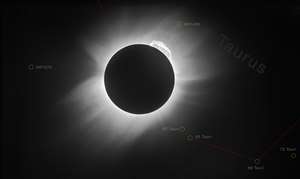Eddington experiment
The Eddington experiment was an observational test of General Relativity, organised by the British astronomers Frank Watson Dyson and Arthur Stanley Eddington in 1919. The observations were of the total solar eclipse of 29 May 1919 and were carried out by two expeditions, one to the West African island of Príncipe, and the other to the Brazilian town of Sobral. The aim of the expeditions was to measure the gravitational deflection of starlight passing near the Sun. The value of this deflection had been predicted by Albert Einstein in a 1911 paper, and was one of the tests proposed for his 1915 theory of General Relativity. Following the return of the expeditions, the results were presented by Eddington to the Royal Society of London, and, after some deliberation, were accepted. Widespread newspaper coverage of the results led to worldwide fame for Einstein and his theories.
Background
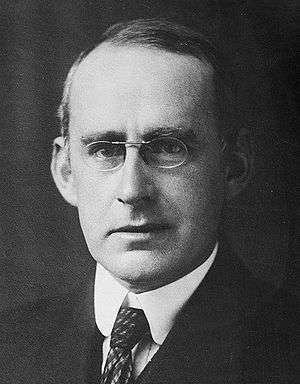
One of the first considerations of gravitational deflection of light was published in 1801, when Johann Georg von Soldner pointed out that Newtonian gravity predicts that starlight will be deflected when it passes near a massive object. Initially, in a paper published in 1911, Einstein had incorrectly calculated that the amount of light deflection was the same as the Newtonian value. There had been plans by an Argentinian team to measure the amount of deflection by making observations of an eclipse in Brazil in 1912, but bad weather prevented observations being made. Eddington had taken part in a British expedition to Brazil to observe the 1912 eclipse.
Although Einstein's main work on general relativity was not published until 1915, he was aware before then that his 1911 calculation had been wrong, and that in fact the predicted effect in the Newtonian model is only half the value predicted by general relativity. This suggested a possible test for his theory, and in 1913 Einstein asked George Ellery Hale to suggest a way of detecting the deflection of light from a star as it passed the Sun. Hale suggested this could be done during a total solar eclipse. This led to another eclipse expedition, with German and US astronomers, which took place in 1914. It was organised by Erwin Finlay-Freundlich, from the University of Berlin, where Einstein was working at the time, and included the US astronomer William Wallace Campbell from the Lick Observatory. The expedition travelled to the Crimea to observe the eclipse of 21 August. However, the First World War started in July of that year, and Germany declared war on Russia on 1 August. The German astronomers were either forced to return home or were taken prisoner by the Russians. Although the US astronomers were not detained, clouds prevented observations being made during the eclipse.
Eddington's interest in general relativity began in 1916, during World War I, when he read papers by Einstein (presented in Berlin, Germany, in 1915), which had been sent by the neutral Dutch physicist Willem de Sitter to the Royal Astronomical Society in Britain. Eddington, later said to be one of the few people at the time to understand the theory, realised its significance and lectured on relativity at a meeting at the British Association in 1916. He emphasised the importance of testing the theory by methods such as eclipse observations of light deflection, and the Astronomer Royal, Frank Watson Dyson began to make plans for the eclipse of May 1919, which would be particularly suitable for such a test. Eddington also produced a major report on general relativity for the Physical Society, published as Report on the Relativity Theory of Gravitation (1918). Eddington also lectured on relativity at Cambridge University, where he had been professor of astronomy since 1913.[1]
Wartime conscription in Britain was introduced in 1917. At the age of 34, Eddington was eligible to be drafted into the military, but his exemption from this was obtained by his university on the grounds of national interest. This exemption was later appealed by the War Ministry, and at a series of hearings in June and July 1918, Eddington, who was a Quaker, stated that he was a conscientious objector, based on religious grounds.[2] At the final hearing, the Astronomer Royal, Frank Watson Dyson, supported the exemption by proposing that Eddington undertake an expedition to observe the total eclipse in May the following year to test Einstein's General Theory of Relativity. The appeal board granted a twelve months extension for Eddington to do so. Although this extension was rendered moot by the signing of the Armistice in November, ending the war, the expedition went ahead as planned.
Theory
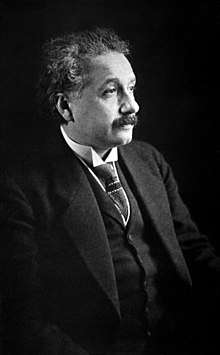
The theory behind the experiment concerns the predicted deflection of light by the Sun. The first observation of light deflection was performed by noting the change in position of stars as they passed near the Sun on the celestial sphere. The approximate angular deflection δφ for a massless particle coming in from infinity and going back out to infinity is given by the following formula:[3]
Here, b can be interpreted as the distance of closest approach. Although this formula is approximate, it is accurate for most measurements of gravitational lensing, due to the smallness of the ratio rs/b. For light grazing the surface of the sun, the approximate angular deflection is roughly 1.75 arcseconds. This is twice the value predicted by calculations using the Newtonian theory of gravity. It was this difference in the deflection between the two theories that Eddington's expedition, and other later eclipse observers would attempt to observe.
Expeditions and observations
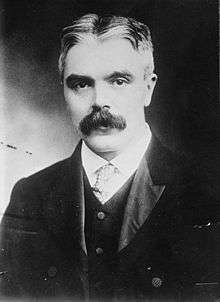
The aim of the expeditions was to take advantage of the shielding effect of the Moon during a total solar eclipse, and to use astrometry to measure the positions of the stars in the sky around the Sun during the eclipse. These stars, not normally visible in the daytime due to the brightness of the Sun, would become visible during the moment of totality when the Moon covered the solar disc. A difference in the observed position of the stars during the eclipse, compared to their normal position at night, would indicate that the light from these stars had bent as it passed close to the Sun. Dyson, when planning the expedition in 1916, had chosen the 1919 eclipse because it would take place with the Sun in front of a bright group of stars called the Hyades. The brightness of these stars would make it easier to measure any changes in position.
Two teams of two people were to be sent to make observations of the eclipse at two locations: the West African island of Príncipe and the Brazilian town of Sobral.
The Príncipe expedition members were Eddington and Edwin Turner Cottingham, from the Cambridge Observatory, while the Sobral expedition members were Andrew Crommelin and Charles Rundle Davidson, from the Greenwich Observatory in London. Eddington was Director of the Cambridge Observatory, and Cottingham was a clockmaker who worked on the observatory's instruments. Similarly, Crommelin was an assistant at the Greenwich Observatory, while Davidson was one of the observatory's computers.
The expeditions were organised by the Joint Permanent Eclipse Committee, a joint committee between the Royal Society and the Royal Astronomical Society, chaired by Dyson, the Astronomer Royal. The funding application for the expedition was made to the Government Grant Committee, asking for £100 for instruments and £1000 for travel and other costs.
Sobral

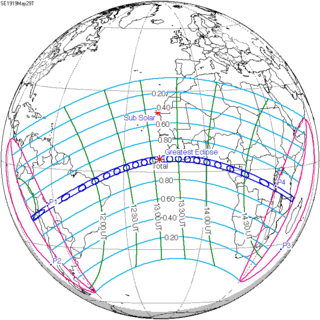
The Sobral equipment included one astrographic lens from the Greenwich Observatory, and another from the Royal Irish Academy.
Principe
The equipment used for the Principe expedition was an astrographic lens borrowed from the Radcliffe Observatory in Oxford. Eddington sailed from England in March 1919. By mid-May he had his equipment set up on Principe, an island in the Gulf of Guinea off the coast of West Africa, near what was then Spanish Guinea. The eclipse was due to take place in the early afternoon of 29 May, at 2pm, but that morning there was a storm with heavy rain. Eddington wrote:
The rain stopped about noon and about 1.30 ... we began to get a glimpse of the sun. We had to carry out our photographs in faith. I did not see the eclipse, being too busy changing plates, except for one glance to make sure that it had begun and another half-way through to see how much cloud there was. We took sixteen photographs. They are all good of the sun, showing a very remarkable prominence; but the cloud has interfered with the star images. The last few photographs show a few images which I hope will give us what we need ...
Eddington developed the photographs on Principe, and attempted to measure the change in the stellar positions during the eclipse. On 3 June, despite the clouds that had reduced the quality of the plates, Eddington recorded in his notebook: "... one plate I measured gave a result agreeing with Einstein."[4]
Results and publication
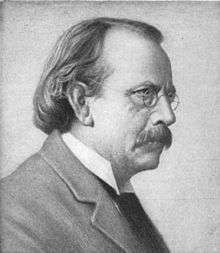
The results were announced at a meeting of the Royal Society in November 1919,[5] and published in the Philosophical Transactions of the Royal Society in 1920.[6] Following the return of the expedition, Eddington was addressing a dinner held by the Royal Astronomical Society, and, showing his more light-hearted side, composed the following verse that parodied the style of the Rubaiyat of Omar Khayyam:[7]
Oh leave the Wise our measures to collate
One thing at least is certain, light has weight
One thing is certain and the rest debate
Light rays, when near the Sun, do not go straight.— Arthur Stanley Eddington, RAS dinner[8]
Immediate impact
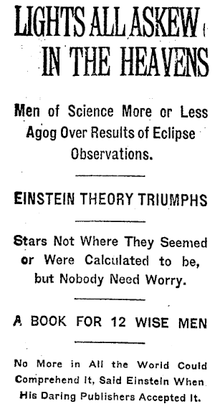
The result was considered spectacular news and made the front page of most major newspapers. It made Einstein and his theory of general relativity world-famous. Einstein has been quoted as describing what his reaction would have been if general relativity had not been confirmed by Eddington and Dyson in 1919: "Then I would feel sorry for the dear Lord. The theory is correct anyway." [9]
Later research
Although the Eddington experiment and the publication of its results had an immediate impact in the popular press, the acceptance by the worldwide scientific community was less swift. Understanding of general relativity among other scientists was still poor, and during the 1920s scepticism about the theory and the results continued until new eclipse observations and other tests of relativity settled the matter. An important role in this was played by the Lick Observatory and the Mount Wilson Observatory, both in California, USA. Astronomers from the Lick Observatory were one of several expeditions that observed the 21 September 1922 solar eclipse in Australia.
In the post-Newtonian tests of gravity, the parameterized post-Newtonian formalism parameterizes, in terms of ten adjustable parameters, all the possible departures from Newton's law of universal gravitation. The earliest parameterizations of the post-Newtonian approximation were performed by Eddington (1922). The parameter concerned with the amount of deflection of light by a gravitational source is the so-called Eddington parameter (γ). It is the best constrained of the ten post-Newtonian parameters.
Criticism and legacy
The early accuracy of eclipse measurements, however, was poor. Dyson et al. quoted an optimistically low uncertainty in their measurement, which is argued by some[10] to have been plagued by systematic error and possibly confirmation bias, although modern reanalysis of the dataset suggests that Eddington's analysis was accurate.[11][12]
In 1801 Johann Georg von Soldner had pointed out that Newtonian gravity predicts that starlight will bend around a massive object, but the predicted effect is only half the value predicted by general relativity as calculated by Einstein in his 1911 paper. The results of Soldner were revived by the Nobel laureate Philipp Lenard in an attempt to discredit Einstein.[13] Eddington had been aware in 1919 of the alternative predictions. Considerable uncertainty remained in these measurements for almost fifty years, until observations started being made at radio frequencies. It was not until the late 1960s that it was definitively shown that the amount of deflection was the full value predicted by general relativity, and not half that number.
References
- Following the eclipse expedition in 1919, Eddington published Space Time and Gravitation (1920), and his university lectures would form the basis for his magnum opus on the subject, Mathematical Theory of Relativity (1923), said by Einstein to be: "... the finest presentation of the subject in any language."
- Stanley, Matthew (2003). "'An Expedition to Heal the Wounds of War': The 1919 Eclipse and Eddington as Quaker Adventurer". Isis. 94 (1): 57–89. Bibcode:2003Isis...94...57S. doi:10.1086/376099. PMID 12725104.
- For the derivation of this formula, see the article on the Two-body problem in general relativity.
- Crelinsten, Jeffrey (2016). Einstein's Jury: The Race to Test Relativity. Princeton University Press. p. 139.
- "The Guardian". 12 May 2019. Retrieved 27 September 2019.
- Dyson, F. W.; Eddington, A. S.; Davidson, C. (1920). "A Determination of the Deflection of Light by the Sun's Gravitational Field, from Observations Made at the Total Eclipse of May 29, 1919". Philosophical Transactions of the Royal Society A: Mathematical, Physical and Engineering Sciences. 220 (571–581): 291–333. Bibcode:1920RSPTA.220..291D. doi:10.1098/rsta.1920.0009.
- O'Connor, J. J.; Robertson, E.F. (October 2003). "Arthur Stanley Eddington". The MacTutor History of Mathematics archive. Retrieved 27 May 2019.
- Douglas, A. V. (1956). The Life of Arthur Stanley Eddington.
- Rosenthal-Schneider, Ilse (1980). Reality and Scientific Truth. Wayne State University Press. p. 74.
- Collins, Harry; Pinch, Trevor (1993). The Golem. Cambridge University Press. ISBN 0521477360.
- Kennefick, Daniel (2005). "Not Only Because of Theory: Dyson, Eddington and the Competing Myths of the 1919 Eclipse Expedition". Proceedings of the 7th Conference on the History of General Relativity. 44: 89–101. arXiv:0709.0685. doi:10.1016/j.shpsa.2012.07.010.
- Ball, Phillip (7 September 2007). "Arthur Eddington Was Innocent". Nature. doi:10.1038/news070903-20.
- Lenard, P. (1921). "Über die Ablenkung eines Lichtstrahls von seiner geradlinigen Bewegung der Planeten und Monde nach der Einsteinschen Gravitationstheorie". Phys. Z. 19: 156–163.
Sources and further reading
- The Golem: What You Should Know About Science (1993) - Harry M. Collins and Trevor Pinch
- Einstein's Jury: The Race to Test Relativity (2016) - Jeffrey Crelinsten
- Einstein's War: How Relativity Triumphed Amid the Vicious Nationalism of World War I (2019) - Matthew Stanley
- No Shadow of a Doubt: The 1919 Eclipse That Confirmed Einstein's Theory of Relativity (2019) - Daniel Kennefick. Princeton University Press.
- Gravity’s Century: From Einstein’s Eclipse to Images of Black Holes (2019) - Ron Cowen
External links
- Eclipse 1919, website about the eclipse, the expeditions and centenary events
- Eddington's Eclipse and Einstein's Celebrity (BBC World Service)
- The man who made Einstein world-famous (BBC News, 24 May 2019)
- Matthew Stanley and Einstein's War (Center for Human Imagination)
- 100 years on: the pictures that changed our view of the universe (The Observer, 12 May 2019)
- How the 1919 Solar Eclipse Made Einstein the World's Most Famous Scientist (Discover magazine, May 2019)
- A Total Solar Eclipse 100 Years Ago Proved Einstein’s General Relativity (Smithsonian Magazine, 24 May 2019)
- Einstein, Eddington and the 1919 eclipse (Nature, April 2019)
- Arthur S. Eddington: From Physics to Philosophy and Back Again (Eddington Conference, 27–29 May 2019, Paris)
